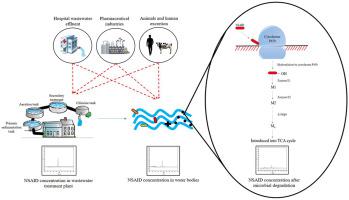Journal of Environmental Management ( IF 8.7 ) Pub Date : 2021-09-16 , DOI: 10.1016/j.jenvman.2021.113694 Aishwarya Rastogi 1 , Manoj Kumar Tiwari 2 , Makarand M Ghangrekar 3

|
In recent years, Non-Steroidal Anti-Inflammatory Drugs (NSAIDs) have surfaced as a novel class of pollutants due to their incomplete degradation in wastewater treatment plants and their inherent ability to promote physiological predicaments in humans even at low doses. The occurrence of the most common NSAIDs (diclofenac, ibuprofen, naproxen, and ketoprofen) in river water, groundwater, finished water samples, WWTPs, and hospital wastewater effluents along with their toxicity effects were reviewed. The typical concentrations of NSAIDs in natural waters were mostly below 1 μg/L, the rivers receiving untreated wastewater discharge have often showed higher concentrations, highlighting the importance of effective wastewater treatment. The critical analysis of potential, pathways and mechanisms of microbial degradation of NSAIDs were also done. Although studies on algal and fungal strains were limited, several bacterial strains were known to degrade NSAIDs. This microbial ability is attributed to hydroxylation by cytochrome P450 because of the decrease in drug concentrations in fungal cultures of Phanerochaete sordida YK-624 on incubation with 1-aminobenzotriazole. Moreover, processes like decarboxylation, dehydrogenation, dechlorination, subsequent oxidation, demethylation, etc. also constitute the degradation pathways. A wide array of enzymes like dehydrogenase, oxidoreductase, dioxygenase, monooxygenase, decarboxylase, and many more are upregulated during the degradation process, which indicates the possibility of their involvement in microbial degradation. Specific hindrances in upscaling the process along with analytical research needs were also identified, and novel investigative approaches for future monitoring studies are proposed.
中文翻译:

非甾体抗炎药(NSAIDs)的环境发生、毒性和微生物降解综述
近年来,由于非甾体抗炎药 (NSAID) 在污水处理厂中不完全降解,并且即使在低剂量下也能促进人体生理困境,因此它们已成为一类新型污染物。审查了河水、地下水、成品水样、污水处理厂和医院废水中最常见的非甾体抗炎药(双氯芬酸、布洛芬、萘普生和酮洛芬)的出现及其毒性效应。天然水体中NSAIDs的典型浓度大多低于1μg/L,接收未经处理的废水排放的河流往往表现出更高的浓度,突出了有效废水处理的重要性。还对非甾体抗炎药的微生物降解潜力、途径和机制进行了批判性分析。尽管对藻类和真菌菌株的研究有限,但已知有几种细菌菌株可降解 NSAID。这种微生物能力归因于细胞色素 P450 的羟基化作用,因为在与 1-氨基苯并三唑一起孵育时,Phanerochaete sordida YK-624 真菌培养物中的药物浓度降低。此外,脱羧、脱氢、脱氯、后续氧化、脱甲基等过程也构成降解途径。多种酶,如脱氢酶、氧化还原酶、双加氧酶、单加氧酶、脱羧酶等,在降解过程中被上调,这表明它们可能参与微生物降解。还确定了升级过程以及分析研究需求的具体障碍,



























 京公网安备 11010802027423号
京公网安备 11010802027423号